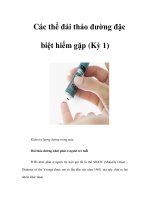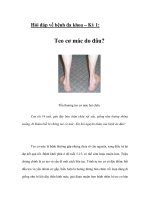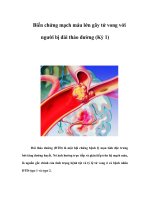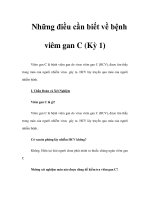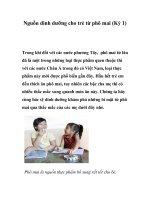Chapter 139. Haemophilus Infections (Kỳ 1) Harrison''''s Internal Medicine Chapter 139. pdf
Bạn đang xem bản rút gọn của tài liệu. Xem và tải ngay bản đầy đủ của tài liệu tại đây (45.18 KB, 5 trang )
Chapter 139. Haemophilus Infections
(Kỳ 1)
Harrison's Internal Medicine > Chapter 139. Haemophilus Infections
Haemophilus influenzae
Microbiology
Haemophilus influenzae was first recognized in 1892 by Pfeiffer, who
erroneously concluded that the bacterium was the cause of influenza. The
bacterium is a small (1- by 0.3-µm) gram-negative organism of variable shape;
hence, it is often described as a pleomorphic coccobacillus. In clinical specimens
such as cerebrospinal fluid (CSF) and sputum, it frequently stains only faintly with
phenosafranin and therefore can easily be overlooked.
H. influenzae grows both aerobically and anaerobically. Its aerobic growth
requires two factors: hemin (X factor) and nicotinamide adenine dinucleotide (V
factor). These requirements are used in the clinical laboratory to identify the
bacterium. Caution must be used to distinguish H. influenzae from H.
haemolyticus, a respiratory tract commensal that has identical growth
requirements. H. haemolyticus has classically been distinguished from H.
influenzae by hemolysis on horse blood agar. However, a significant proportion of
isolates of H. haemolyticus have recently been recognized as nonhemolytic.
Analysis of 16S ribosomal sequences is one reliable method to distinguish these
two species.
Six major serotypes of H. influenzae have been identified; designated a
through f, they are based on antigenically distinct polysaccharide capsules. In
addition, some strains lack a polysaccharide capsule and are referred to as
nontypable strains. Type b and nontypable strains are the most relevant strains
clinically (Table 139-1), although encapsulated strains other than type b can cause
disease. H. influenzae was the first free-living organism to have its entire genome
sequenced.
Table 139-1 Charact
eristics of Type b and Nontypable Strains of
Haemophilus influenzae
Feature Type b Strains Nontypable Strains
Capsule Ribosyl-ribitol
phosphate
Unencapsulated
Pathogenesis
Invasive infections
due to hematogenous
spread
Mucosal infections due to
contiguous spread
Clinical
manifestations
Meningitis and
invasive infections in
incompletely immunized
infants and children
Otitis media in infants and
children; lower respiratory tract
infections in adults with chronic
bronchitis
Evolutionary
history
Basically clonal Genetically diverse
Vaccine
Highly effective
conjugate vaccines
None available; under
development
The antigenically distinct type b capsule is a linear polymer composed of
ribosyl-ribitol phosphate. Strains of H. influenzae type b (Hib) cause disease
primarily in infants and children <6 years of age. Nontypable strains are primarily
mucosal pathogens but occasionally cause invasive disease.
Epidemiology and Transmission
H. influenzae, an exclusively human pathogen, is spread by airborne
droplets or by direct contact with secretions or fomites. Nontypable strains
colonize the upper respiratory tract of up to three-fourths of healthy adults.
Colonization with nontypable H. influenzae is a dynamic process; new strains are
acquired and other strains are replaced periodically.
The widespread use of Hib conjugate vaccines in many industrialized
countries has resulted in striking decreases in the rate of nasopharyngeal
colonization by Hib and in the incidence of Hib infection (Fig. 139-1). However,
the majority of the world's children remain unimmunized. Worldwide, invasive
Hib disease occurs predominantly in unimmunized children and in those who have
not completed the primary immunization series.
Figure 139-1
Estimated incidence (rate per 100,000)
of invasive disease due to
Haemophilus influenzae type b among children <5 years of age: 1987–
2000.
(Data from the Centers for Disease Control and Prevention.)
Certain groups have a higher incidence of invasive Hib disease than the
general population. The incidence of meningitis due to Hib has been three to four
times higher among black children than among white children in several studies.
In some Native American groups, the incidence of invasive Hib disease is 10 times
higher than that in the general population. Although this increased incidence has
not yet been accounted for, several factors may be relevant, including age at
exposure to the bacterium, socioeconomic conditions, and genetic differences in
the ability to mount an immune response.
